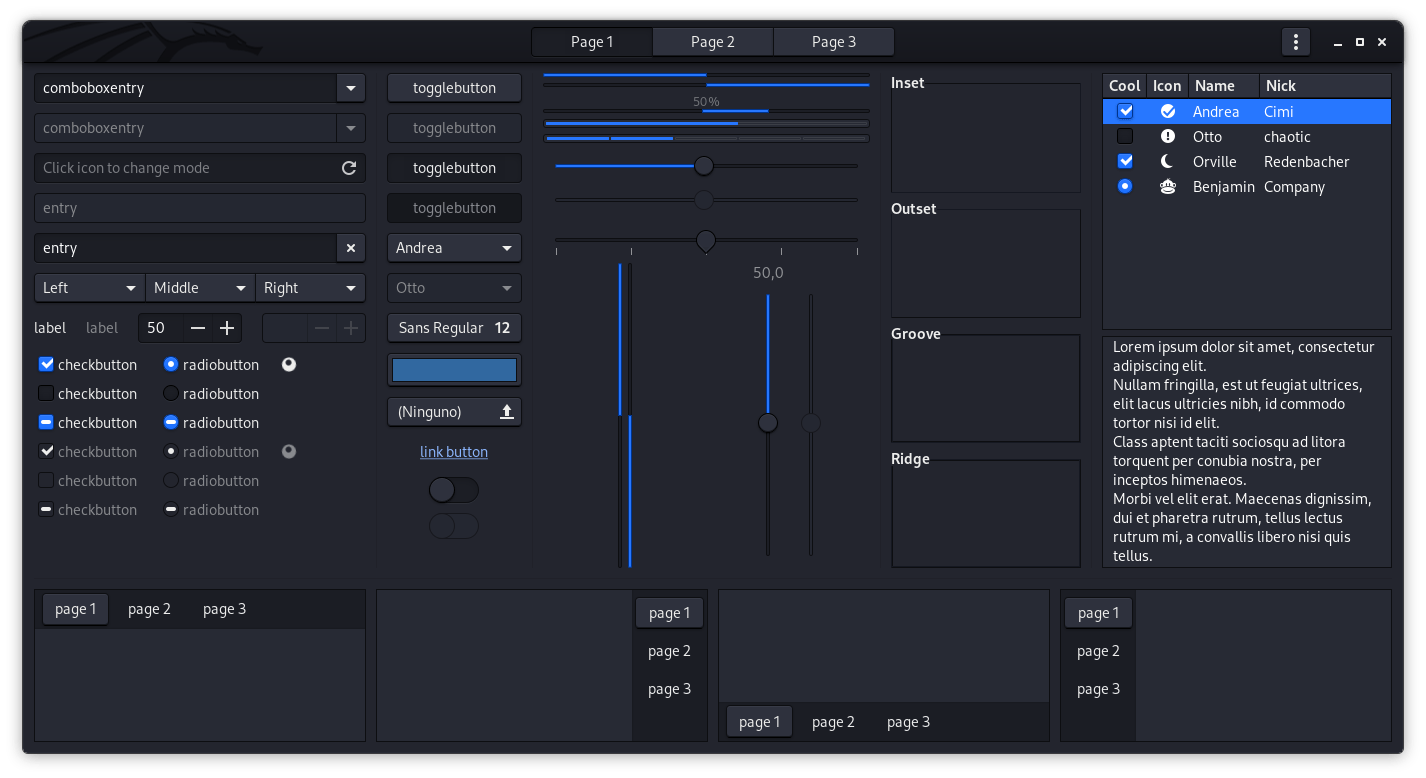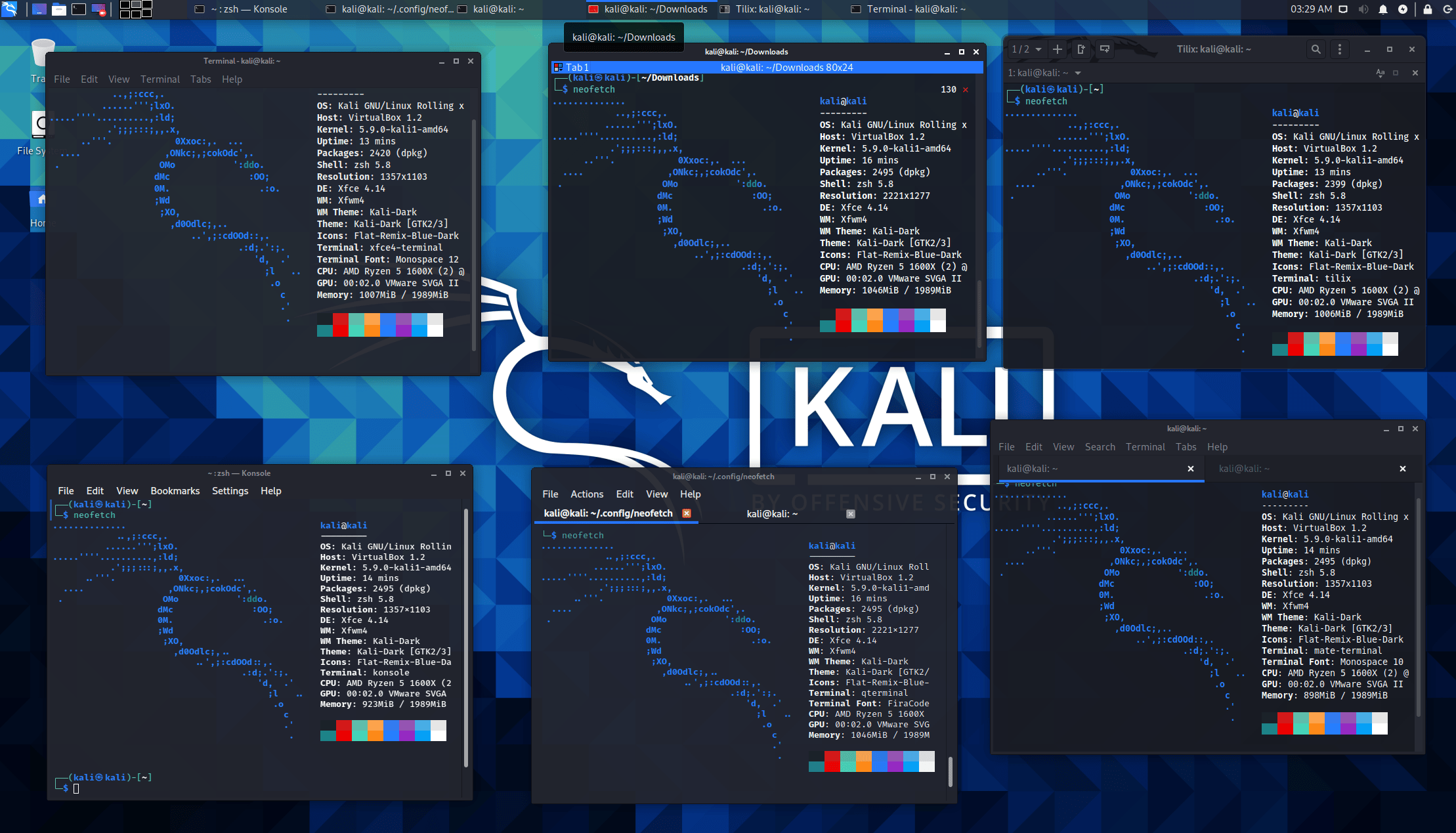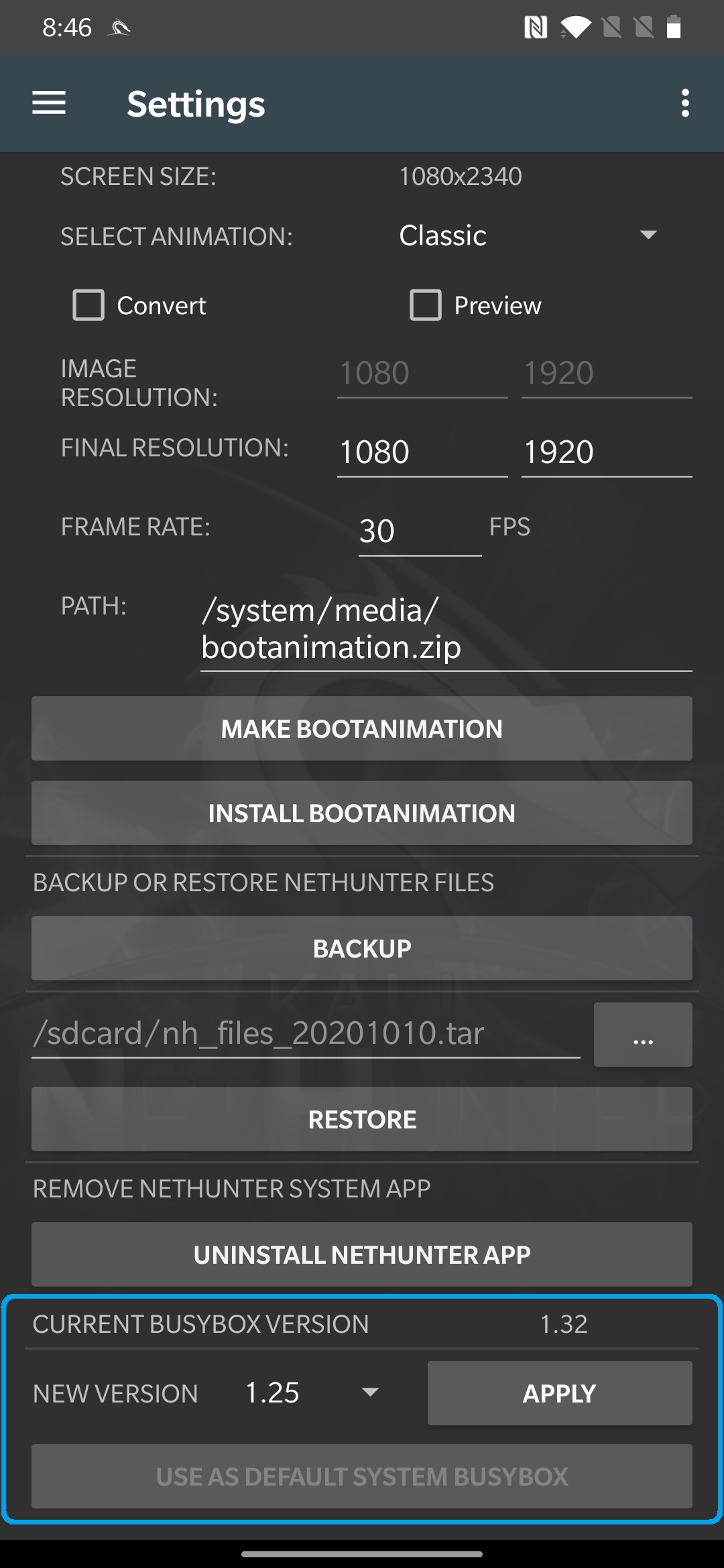- Знакомство с Kali Linux Rolling
- 3 thoughts to “Знакомство с Kali Linux Rolling”
- Kali Linux 2021.1 Release (Command-Not-Found)
- Xfce & KDE Updates
- Terminals Tweaks
- Finding Commands That Didn’t Want To Be Found
- Partnerships with Tools Authors
- New Tools in Kali
- Kali’s Website
- Wallpapers
- Kali NetHunter Updates
- Kali ARM Updates
- Download Kali Linux 2021.1
Знакомство с Kali Linux Rolling
Команда Kali Linux, известного дистрибутива для тестирования на проникновение и других тестов на безопасность, анонсировала новый релиз, совместимый с UEFI. Вот мои первые впечатления после его установки.
У меня есть отличный способ вас порадовать — три превосходные новости в одном анонсе!
- Команда Kali Linux (преемника BackTrack), хорошо известного, как один из лучших дистрибутивов для тестирования безопасности компьютерных систем, объявила о выпуске новой версии. Этот факт сам по себе уже можно считать отличной новостью.
- Вместе с релизом Kali-Rolling (2016.1), Kali Linux официально становится дистрибутивом с непрерывными обновлениями. Ранее Kali был основан на стабильной версии дистрибутива Debian, поэтому, команде, фактически, приходилось следить за крупными релизами Debian и обновлять свою систему в соответствии с ними. Теперь Kali базируется на тестовом дистрибутиве Debian, поэтому может получать обновления постоянно. Кроме этого, разработчики Kali будут выпускать обновления для инструментов, который они добавили в Debian, превратив его в дистрибутив Kali.
- Но это ещё не всё. Новый дистрибутив совместим с UEFI, и без проблем устанавливается на все системы, которые я успел проверить. Для меня это самая лучшая новость, поскольку я потратил уйму времени, сражаясь с предыдущими версиями Kali, которые не хотели правильно загружаться на системах с UEFI (НЕ в режиме Legacy-загрузки)
Похоже, они наконец-то сделали то, что, по моему мнению, должны были сделать уже давно — просто воспользовались установщиком Debian, который уже умеет работать с UEFI. Конечно, это всё тот же текстовый установщик без удобного графического интерфейса (при желании, можно добавить ограниченную поддержку графики). Но я надеюсь, что люди, пользующиеся Kali, обладают достаточным опытом, чтобы с ним разобраться и понимают, что простая вещь, надёжно срабатывающая каждый раз, гораздо предпочтительнее чего-то, что работает «иногда» или даже «большую часть времени» (если когда-нибудь захотите услышать моё мнение обо всём этом, спросите про сегодняшнюю общую готовности принимать вещи, который «чаще всего работают»).
Объявление о релизе вдаётся в большие подробности об изменениях в плавающем дистрибутиве, а так же рассказывает о том, как выполнить обновление предыдущего релиза (2.0) до новой версии, без необходимости устанавливать систему заново.
Новые ISO образы можно скачать со страницы загрузок Kali, и они тоже являются довольно впечатляющими продуктами. Их можно загрузить в (обычном) Live режиме, (экспертном) Live режиме или установить напрямую. Насколько я могу сказать, не существует способа установки из загруженного образа, и я считаю это хорошим нововведением, поскольку предыдущие установщики такого типа совершенно не умели работать с системами на базе прошивки UEFI.
На странице загрузок вы найдёте несколько различных образов:
- Полная версия с рабочим столом Gnome 3 и всеми инструментами для тестирования (2,6 Гб).
- Лёгкая версия с рабочим столом Xfce и «10 лучшими» пакетами инструментов (800 Мб).
- Мини версия, которую можно установить через интернет (30 Мб). Но она не поддерживает системы с UEFI.
- ARM образы (armel и armhf, 700 Мб). Правда! На следующей неделе я смогу установить Kali на свой Raspberry Pi? Ох, это будет интересно…
Пока что я поработал только с полной версией, но думаю, что и лёгкая окажется достаточно интересной. Не только для тех, кто предпочитает Xfce (или терпеть не может Gnome 3), но и потому, что даёт вам шанс настроить систему в зависимости от своих потребностей. Вы начинает с 10 лучшими пакетами и можете добавить к ним всё, что вам потребуется.
ISO образы можно записать на DVD или переместить на USB-накопитель. После загрузки, вы увидите меню, предлагающее несколько режимов прямой загрузки на выбор (обычный, отказоустойчивый, экспертный, устойчивый и устойчивый с шифрованием), вместе с установкой и графической установкой. Как я уже упомянул, не слишком полагайтесь на графическую установку. Это всё лишь простой текстовый установщик Debian с небольшими вкраплениями графики.
Процесс установки проходит довольно рутинно, особенно если вы уже когда-нибудь имели дело с Debian. Хочу сделать только два замечания. Во-первых, ручная разбивка разделов работает очень хорошо. Я выбрал второй раздел FAT32 в качестве загрузочного раздела EFI, и мне пришлось создать новый корневой раздел. Подобные действия привели бы к отказу многих других установщиков, но здесь всё прошло без проблем.
Во-вторых, он не создаёт учётную запись обычного пользователя. Система регистрирует только root и просит вас ввести пароль. Так что, после перезагрузки вам не придётся чесать голову, пытаясь выяснить имя аккаунта. И не пытайтесь использовать стандартный пароль Kali для корневого пользователя. Вместо этого, попытайтесь вспомнить, пароль, введённый вами во время установки.
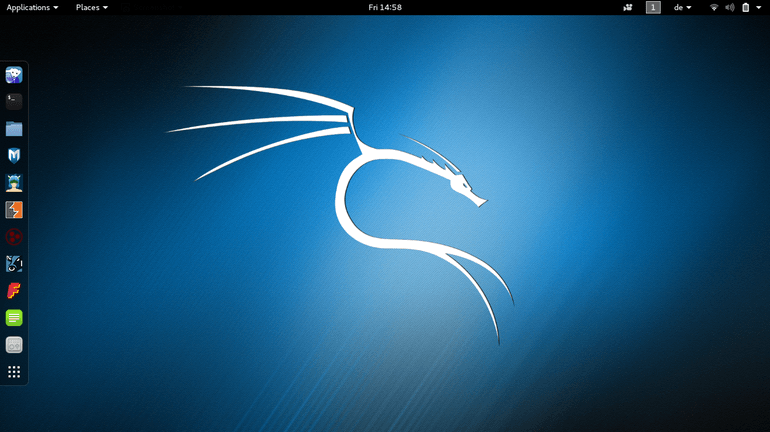
Это стандартный рабочий стол Kali (Полная версия/Gnome). Мне кажется, это очень неплохая вариация графического окружения Gnome 3. Очевидно, что в неё было вложено много труда. Если вы следили за моим недавним циклом статей по настройке рабочих столов Linux (Gnome), то заметите, что разработчики добавили на верхнюю панель меню Приложения и Места, а так же воспользовались расширением Dash to Dock, чтобы боковая панель оставалась видимой на рабочем столе. Кроме этого, в правом конце панели появились иконки для записи и выбора рабочего пространства. Очень неплохо.
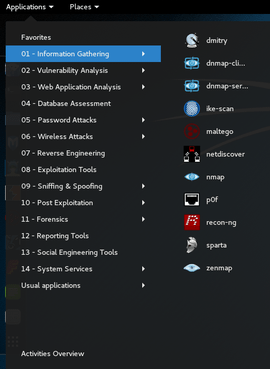
На боковой панели размещены восемь чаще всего используемых приложений безопасности, вместе с браузером, терминалом и файловым менеджером. Удобно.
В меню приложений вы найдёте длинный список категорий, в каждой из которых есть несколько инструментов. Здесь-то вы и начнёте понимать, сколько утилит в действительности входит в состав Kali Linux.
Я серьёзно. Только взгляните на этот список. Сбор информации и анализ уязвимостей. Взлом паролей и беспроводные атаки. Перехват и маскировка. Последующее использование и экспертизы. Просто голова идёт кругом.
Познакомившись с этими меню поближе, вы поймёте, что там нет обычных системных утилит и приложений. Чтобы добраться до них, вам придётся воспользоваться обычным меню активности Gnome, переместив курсор мыши в верхний левый угол экрана (меня это уже начинает раздражать) или, нажав клавишу «Супер» (на ней, чаще всего, изображён логотип Windows).
Пожалуй, на сегодня этого достаточно. Суммируя всё вышесказанное, вышел новый релиз Kali, и он превосходно работает даже на прошивке UEFI. Если вы работаете в сфере сетевой или компьютерной безопасности, то просто обязаны взглянуть на этот дистрибутив. Впрочем, вы, наверное, уже им пользуетесь.
3 thoughts to “Знакомство с Kali Linux Rolling”
Добрый день!
Нужен совет:
Пытаюсь установить Kali Linux на ноут Dexp при помощи установочной usb-флэшки,на которую записан при помощи UnetBootin образ диска Kali Linux 64 bit,скаченный с официального сайта https://www.kali.org/downloads/ . Флешка 3.0 вставлена в usb-порт 3.0 .
В биосе стоит:
Secure Boot — Disable
Launch CMS — Enable
Fast BIOS Mode — такого меню нет.
В загрузке на первом месте стоит флешка.
Если открыть мой-пк под обычной windows 8.1(лицензия),то флешка распознается,как если ли бы это был установочный диск,с какой-либо программой.
Но установка не запускается при запуске ноута! Чем это может быть вызвано?
Уважаемый, используй порт USB 2.0
Во время установки: если Kali не обнаружит источник при проверке носителя, просто вынь флешку и вставь заново. Затем нажми продолжить.
Успехов! 😉
Источник
Kali Linux 2021.1 Release (Command-Not-Found)
Today we’re pushing out the first Kali Linux release of the year with Kali Linux 2021.1. This edition brings enhancements of existing features, and is ready to be downloaded or upgraded if you have an existing Kali Linux installation.
- Xfce 4.16 — Our preferred and current default desktop environment has been updated and tweaked
- KDE 5.20 — Plasma also received a version bump
- Terminals — mate-terminal , terminator and tilix all had various work carried out on them
- Command Not Found — A helping hand to say if a program needs to be installed
- Partnership with more tool authors — BC Security & Joohoi have been producing great tools and we want to support them
- New tools & updates — Multiple new tools have been added to Kali and are ready for you
- Kali NetHunter — New BusyBox & Rucky version, and boot-animation
- Kali ARM — Preliminary support for Parallels on Apple Silicon (Apple M1) & Raspberry Pi 400 (WiFi Support)
The Kali project itself also has a couple different changes:
- New Kali website — You may have noticed a few things looking different
- Kali newsletter — Rather than you coming to us for updates, we can push them to your inbox
Xfce & KDE Updates
How you choose to interact with Kali is completely up to you. You may want to access Kali locally or remotely, either graphically or on the command line. Even when you pick a method, there are still options you can choose from, such as a desktop environment.
By default, Kali uses Xfce, but during the setup process, allows for GNOME, KDE, or no GUI to be selected. After the setup is complete, you can install even more. We have pre-configurations for Enlightenment, i3, LXDE, and MATE as well.
So when a desktop environment gets an update, they often enhance day-to-day activities for their users. It’s best to hear it straight from the authors, for a tour of what’s changed:
Below is our tweaked GTK3 theme, on Xfce:
Terminals Tweaks
When we use Kali, we spend a significant amount of time using the command line. A lot of the time, we do it using a local terminal (rather than in a console or remote SSH). With the options of desktop environments, there are also choices when it comes to the terminals (same with what shell to use). We have been working away on various terminals ( xfce4-terminal , tmux , tilix , konsole , qterminal , and mate-terminal ) to “Kali-fy” them:
Finding Commands That Didn’t Want To Be Found
A while ago, we changed the default set of tools installed in Kali. Most users know they can either install a one-off package, or revert back to the old set of defaults ( apt install kali-linux-large ). But to help communicate our changes (as well as any new tools), we have now included command-not-found by default. This is an “optional” package, which can be removed without removing all of kali-linux-default .
Without command-not-found installed:
If you are wondering “How does this help me?”, or has the above ever happened to you, we like to think people’s next stage would be to do apt-cache search gitleaks and see it in the network repositories. But we can do better. Now with command-not-found :
As you can see from the above example:
- gitleaks — If the command you entered is the name of an executable available in Kali, it will say the package that you need to install (if its not already!)
- gitleakss — If you are “fat fingered” and make a typo, it may make a suggestion
- badcmd — If you typed in an invalid command that doesn’t exist in Kali, it will give the original message of “command not found”.
So, how can I get this magic? Good question! If you’re:
- Doing a fresh install of Kali Linux 2021.1 or later, it will “just happen” during the setup.
- Updating Kali and you are using a Bash shell, then it will “just happen” too.
- Updating Kali and you are using a Zsh shell, you will need to add the following lines to your
But it doesn’t have to end here. By adding COMMAND_NOT_FOUND_INSTALL_PROMPT=1 to your shell’s environment (e.g.
/.zshrc ), command-not-found will take it one step further, and also prompt you if you want to install the missing package. This change is something we will be putting in in a future release.
Partnerships with Tools Authors
Carrying on from our previous partnership with byt3bl33d3r, we have expanded to supporting:
- BC Security — Giving Kali exclusive early access to “Empire” ( powershell-empire ) & “StarKiller”
- Joohoi — The creator of “Fuzz Faster U Fool (ffuf)”
The announcement with Joohoi is new for Kali 2021.1. Like the previous sponsorships, you can either sponsor him directly to get the latest access to ffuf, use Kali Linux, or wait 30 days until the source code becomes public. However, he has also announced anyone who makes a significant contribution, which gets accepted into the project, also gets access!
New Tools in Kali
It wouldn’t be a Kali release if there weren’t any new tools added! A quick run down of what’s been added (to the network repositories):
- Airgeddon — Audit wireless networks
- AltDNS — Generates permutations, alterations and mutations of subdomains and then resolves them
- Arjun — HTTP parameter discovery suite
- Chisel — A fast TCP/UDP tunnel over HTTP
- DNSGen — Generates combination of domain names from the provided input
- DumpsterDiver — Search secrets in various filetypes
- GetAllUrls — Fetch known URLs from AlienVault’s Open Threat Exchange, the Wayback Machine, and Common Crawl
- GitLeaks — Searches Git repo’s history for secrets and keys
- HTTProbe — Take a list of domains and probe for working HTTP and HTTPS servers
- MassDNS — A high-performance DNS stub resolver for bulk lookups and reconnaissance
- PSKracker — WPA/WPS toolkit for generating default keys/pins
- WordlistRaider — Preparing existing wordlists
Kali’s Website
Until recently, the only way you could be reading this would have been from our RSS feed or directly from our blog (as we only recently made the announcement of the Kali Newletter). You may of noticed already, and we said that it was coming, and it finally has — kali.org has had a face-lift!
We have (finally) moved away from WordPress to Hugo. Similarly to Kali, the website will also be a rolling distribution. The recent change is mostly cosmetic and content (both were long overdue), and we have made plans for new features to be added.
Another upside of the switch is that we can take more advantage of what GitLab has to offer. We recently had an interview with GitLab about the switch.
On the subject of interviews, we also had a word with Mr Robot’s ARG Society if you missed that.
Wallpapers
Just a quick little thing, we have tweaked our wallpaper packages:
- kali-wallpapers-2020.4 — Kali’s wallpapers from 2020.4 and onwards (for the time being)
- kali-wallpapers-2019.4 — Kali’s wallpapers between 2019.4 and 2020.3.
- kali-wallpapers-legacy — BackTrack & Kali nostalgic backgrounds
- kali-wallpapers-all — Every wallpaper
- kali-community-wallpapers — created and submitted by the community (submit yours today!)
With the alterations to the packages, we have taken the time to improve support for Xfce when using them.
Kali NetHunter Updates
BusyBox, one of the core engines of Kali NetHunter, has received a well deserved upgrade to version “1.32.0-nethunter”. BusyBox is used internally to ensure that NetHunter tools and commands are executed consistently across the vast number of different Android versions and vendor modifications. This change, whilst big, should go unnoticed by users and will help developers to port their code to NetHunter with no hassles at all. @yesimxev has added a handy section to the settings menu, which allows developers to select different BusyBox versions for testing:
Speaking of developers: If you have any cool ideas you’d like to see included in Kali NetHunter or if you would like to contribute to this amazing project, please reach out to us in our forums or on GitLab. We would love to hear from you!
Tools have been updated to the latest versions, notably Rucky — the “modern looking USB Rubber Ducky Editor and Attack Launcher”, which has been completely re-written by its author @mayankmetha and released in the Kali NetHunter App Store as version 2.1.
We’ve also been busy working on the visual aspects of Kali NetHunter, with @s133py adding a stunning new boot-animation to the growing selection:
If you have a cool boot-animation you’d like to share, please submit a merge request to our Kali NetHunter boot-animation repository.
Kali ARM Updates
As you may have heard, Apple have released new Macs with their own processors, known as Apple Silicon (Apple M1). So far, only Parallels have released something publicly that people can use for virtualization. To that end, we have generated both an installer & live ISOs ( kali-linux-2021.1-installer-arm64.iso and kali-linux-2021.1-live-arm64.iso ) that can be used with VMs on Apple Silicon Macs. Many thanks to the people who reached out and offered to test and helped us to iron out the bugs. If you’d like to see it in action, David Bombal has put out a video of it.
We have also added support for the Raspberry Pi 400’s wireless card, however it is very important to note that this is not a nexmon firmware, as nexmon does not currently support it.
The Kali ARM build scripts have seen a few more improvements from Francisco Jose Rodriguez Martos and we appreciate the assistance greatly. If you’d like to get involved with ARM, check out the GitLab issue list.
Download Kali Linux 2021.1
Fresh Images: So what are you waiting for? Start downloading already!
Seasoned Kali Linux users are already aware of this, but for the ones who are not, we do also produce weekly builds that you can use as well. If you cannot wait for our next release and you want the latest packages (or bug fixes) when you download the image, you can just use the weekly image instead. This way you’ll have fewer updates to do. Just know that these are automated builds that we do not QA like we do our standard release images. But we gladly take bug reports about those images because we want any issues to be fixed before our next release!
Existing Installs: If you already have an existing Kali Linux installation, remember you can always do a quick update:
You should now be on Kali Linux 2021.1. We can do a quick check by doing:
NOTE: The output of uname -r may be different depending on the system architecture.
As always, should you come across any bugs in Kali, please submit a report on our bug tracker. We’ll never be able to fix what we do not know is broken! And Twitter is not a Bug Tracker!
Источник
